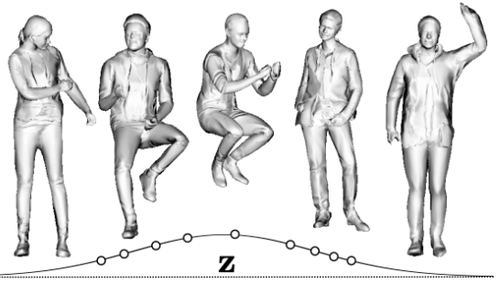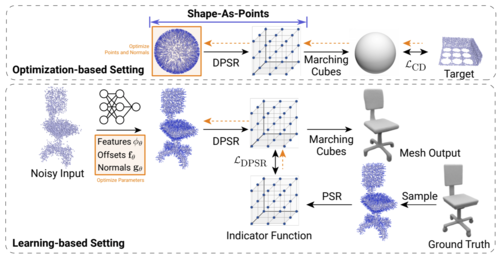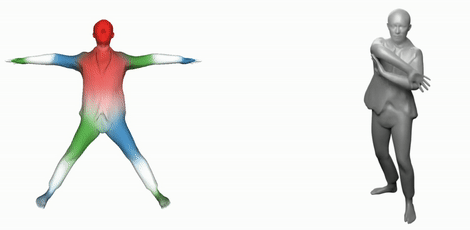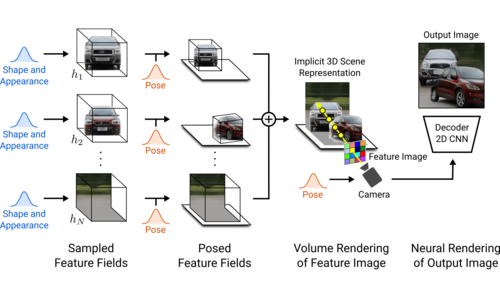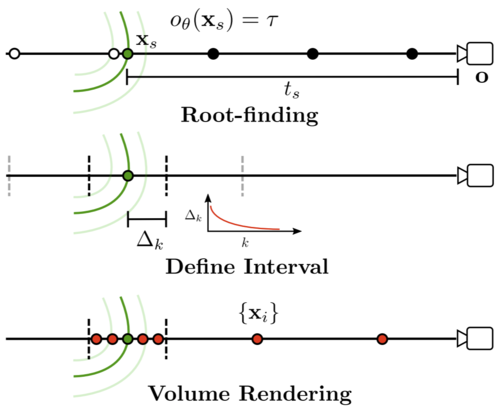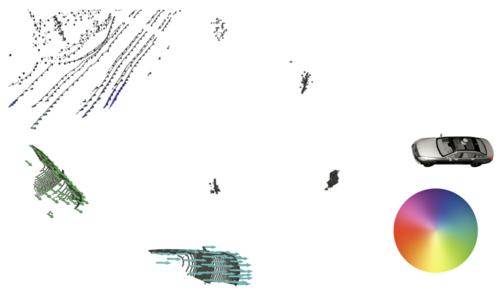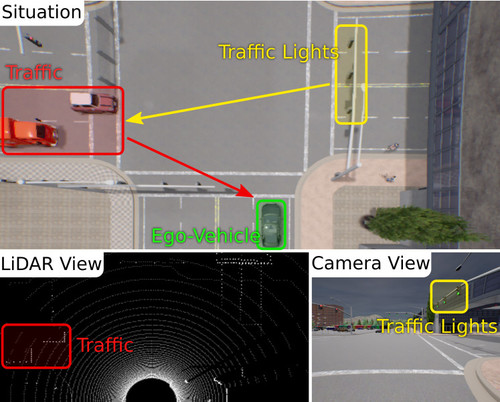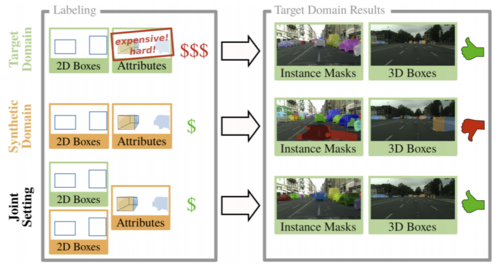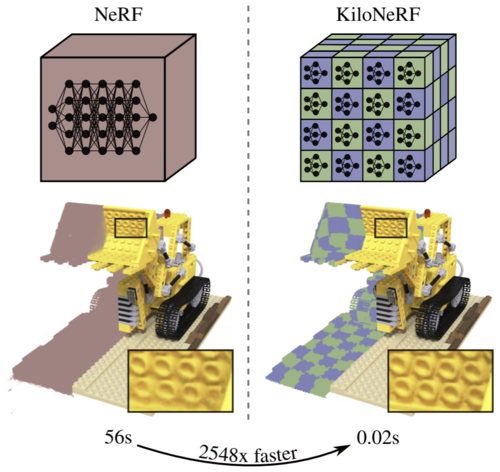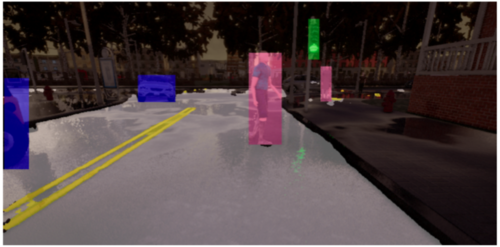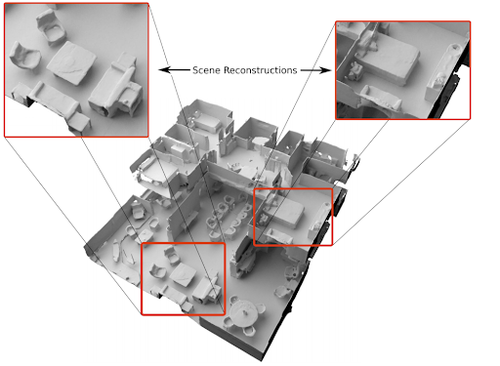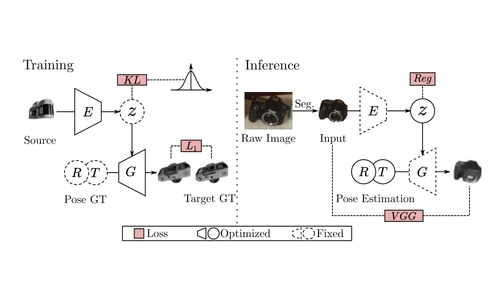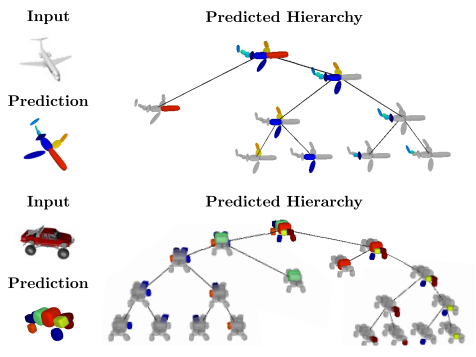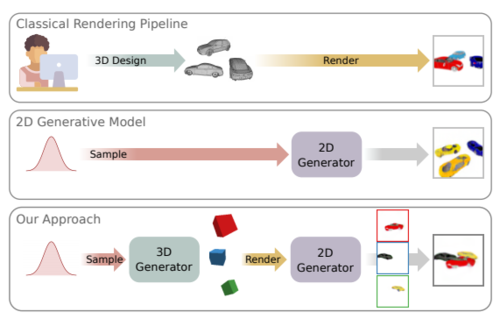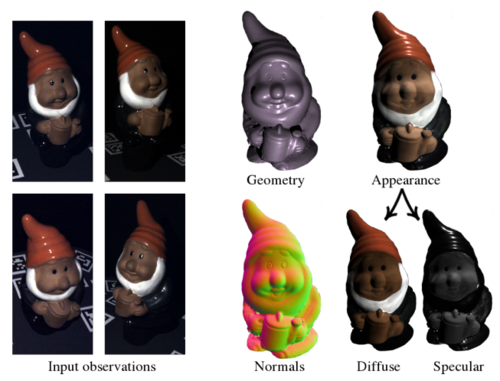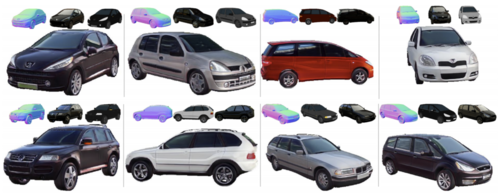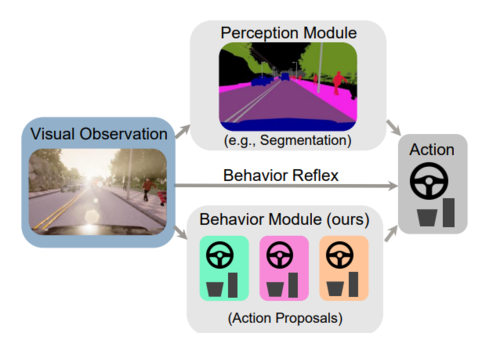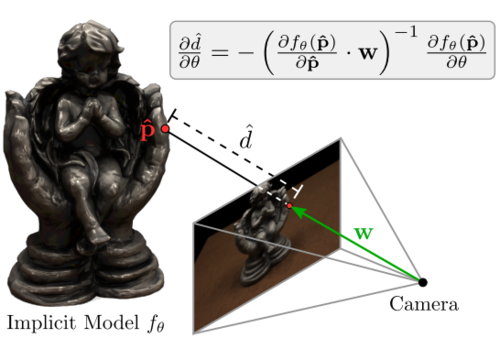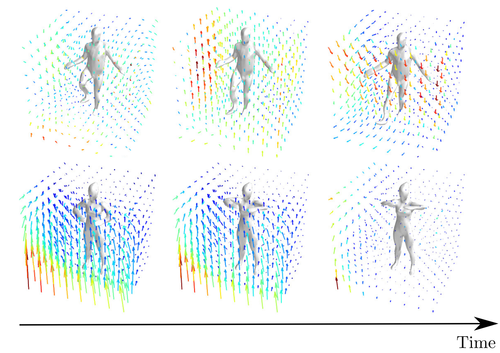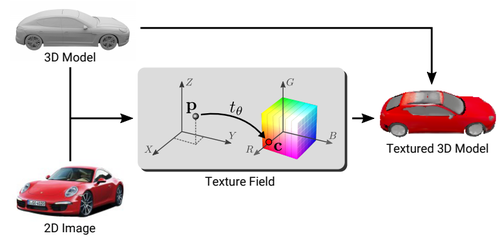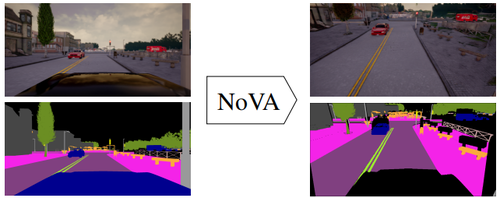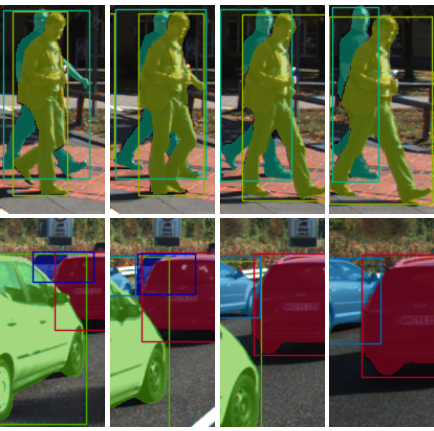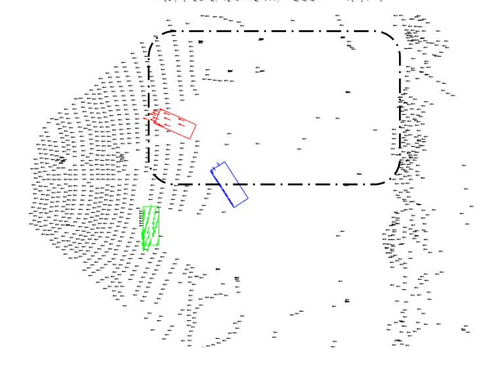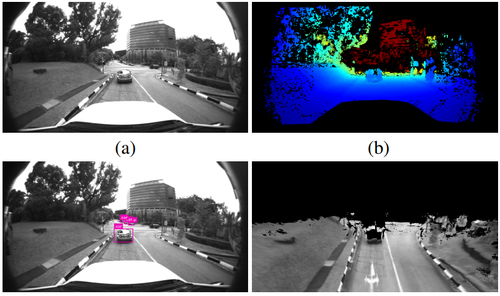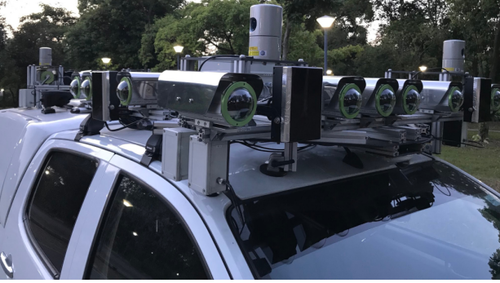2022
ARAH: Animatable Volume Rendering of Articulated Human SDFs
KING: Generating Safety-Critical Driving Scenarios for Robust Imitation via Kinematics Gradients
Hanselmann, N. R. K. C. K. B. A. G. A.
Proceedings 17th European Conference on Computer Vision (ECCV), 13698, pages: 335-352, (Editors: Avidan, S; Brostow, G; Cisse, M; Farinella, GM; Hassner, T), IEEE, ECCV, October 2022 (conference)
TensoRF: Tensorial Radiance Fields
PINA: Learning a Personalized Implicit Neural Avatar from a Single RGB-D Video Sequence
NICE-SLAM: Neural Implicit Scalable Encoding for SLAM
gDNA: Towards Generative Detailed Neural Avatars
Chen, X., Jiang, T., Song, J., Yang, J., Black, M. J., Geiger, A., Hilliges, O.
In 2022 IEEE/CVF Conference on Computer Vision and Pattern Recognition (CVPR 2022), pages: 204395-20405, IEEE, Piscataway, NJ, IEEE/CVF Conference on Computer Vision and Pattern Recognition (CVPR 2022), June 2022 (inproceedings)
RegNeRF: Regularizing Neural Radiance Fields for View Synthesis from Sparse Inputs
2021
Projected GANs Converge Faster
CAMPARI: Camera-Aware Decomposed Generative Neural Radiance Fields
On the Frequency Bias of Generative Models
Schwarz, K., Liao, Y., Geiger, A.
In Advances in Neural Information Processing Systems 34, 22, pages: 18126-18136, (Editors: M. Ranzato and A. Beygelzimer and Y. Dauphin and P. S. Liang and J. Wortman Vaughan), Curran Associates, Inc., Red Hook, NY, 35th Conference on Neural Information Processing Systems (NeurIPS 2021), December 2021 (inproceedings)
ATISS: Autoregressive Transformers for Indoor Scene Synthesis
Paschalidou, D., Kar, A., Shugrina, M., Kreis, K., Geiger, A., Fidler, S.
In Advances in Neural Information Processing Systems 34, 15, pages: 12013-12026, (Editors: M. Ranzato and A. Beygelzimer and Y. Dauphin and P. S. Liang and J. Wortman Vaughan), Curran Associates, Inc., Red Hook, NY, 35th Conference on Neural Information Processing Systems (NeurIPS 2021), December 2021 (inproceedings)
MetaAvatar: Learning Animatable Clothed Human Models from Few Depth Images
Wang, S., Mihajlovic, M., Ma, Q., Geiger, A., Tang, S.
In Advances in Neural Information Processing Systems 34, 4, pages: 2810-2822, (Editors: Ranzato, M. and Beygelzimer, A. and Dauphin, Y. and Liang, P. S. and Wortman Vaughan, J.), Curran Associates, Inc., Red Hook, NY, 35th Conference on Neural Information Processing Systems (NeurIPS 2021), December 2021 (inproceedings)
Shape As Points: A Differentiable Poisson Solver
Peng, S., Jiang, C. M., Liao, Y., Niemeyer, M., Pollefeys, M., Geiger, A.
In Advances in Neural Information Processing Systems 34, 16, pages: 13032-13044, (Editors: M. Ranzato and A. Beygelzimer and Y. Dauphin and P. S. Liang and J. Wortman Vaughan), Curran Associates, Inc., Red Hook, NY, 35th Conference on Neural Information Processing Systems (NeurIPS 2021), December 2021 (inproceedings)
NEAT: Neural Attention Fields for End-to-End Autonomous Driving
Chitta, K., Prakash, A., Geiger, A.
In 2021 IEEE/CVF International Conference on Computer Vision (ICCV), pages: 15773-15783 , IEEE, International Conference on Computer Vision (ICCV), 2021 (inproceedings)
SNARF: Differentiable Forward Skinning for Animating Non-Rigid Neural Implicit Shapes
Chen, X., Zheng, Y., Black, M. J., Hilliges, O., Geiger, A.
In Proc. International Conference on Computer Vision (ICCV), pages: 11574-11584, IEEE, Piscataway, NJ, International Conference on Computer Vision 2021, October 2021 (inproceedings)
GIRAFFE: Representing Scenes as Compositional Generative Neural Feature Fields
UNISURF: Unifying Neural Implicit Surfaces and Radiance Fields for Multi-View Reconstruction
Oechsle, M., Peng, S., Geiger, A.
In International Conference on Computer Vision (ICCV), 2021 (inproceedings)
Locally Aware Piecewise Transformation Fields for 3D Human Mesh Registration
Wang, S., Geiger, A., Tang, S.
In 2021 IEEE/CVF Conference on Computer Vision and Pattern Recognition (CVPR), pages: 7635-7644 , IEEE, Conference on Computer Vision and Pattern Recognition (CVPR), 2021 (inproceedings)
SLIM: Self-Supervised LiDAR Scene Flow and Motion Segmentation
Baur, S., Emmerichs, D., Moosmann, F., Pinggera, P., Ommer, B., Geiger, A.
In 2021 IEEE/CVF International Conference on Computer Vision (ICCV), pages: 13106-13116 , IEEE/CVF International Conference on Computer Vision (ICCV 2021), 2021 (inproceedings)
Neural Parts: Learning Expressive 3D Shape Abstractions with Invertible Neural Networks
Paschalidou, D., Katharopoulos, A., Geiger, A., Fidler, S.
In IEEE/CVF Conference on Computer Vision and Pattern Recognition (CVPR 2021) , pages: 3203-3214 , 2021 IEEE/CVF Conference on Computer Vision and Pattern Recognition (CVPR) , 2021 (inproceedings)
Counterfactual Generative Networks
Multi-Modal Fusion Transformer for End-to-End Autonomous Driving
Prakash, A., Chitta, K., Geiger, A.
In 2021 IEEE/CVF Conference on Computer Vision and Pattern Recognition (CVPR), pages: 7073-7083 , IEEE, Conference on Computer Vision and Pattern Recognition (CVPR), 2021 (inproceedings)
Learning Cascaded Detection Tasks with Weakly-Supervised Domain Adaptation
Hanselmann, N., Schneider, N., Ortelt, B., Geiger, A.
In 2021 IEEE Intelligent Vehicles Symposium (IV), 4th IEEE Intelligent Vehicles Symposium (IV 2021), 2021 (inproceedings)
KiloNeRF: Speeding up Neural Radiance Fields with Thousands of Tiny MLPs
Reiser, C., Peng, S., Liao, Y., Geiger, A.
In 2021 IEEE/CVF International Conference on Computer Vision (ICCV) , pages: 14315-14325 , IEEE/CVF International Conference on Computer Vision (ICCV 2021) , 2021 (inproceedings)
2020
GRAF: Generative Radiance Fields for 3D-Aware Image Synthesis
Schwarz, K., Liao, Y., Niemeyer, M., Geiger, A.
In Advances in Neural Information Processing Systems 33, 25, pages: 20154-20166, (Editors: Larochelle , H. and Ranzato, M. and Hadsell , R. and Balcan , M. F. and Lin, H.), Curran Associates, Inc., Red Hook, NY, 34th Conference on Neural Information Processing Systems (NeurIPS 2020), December 2020 (inproceedings)
Label Efficient Visual Abstractions for Autonomous Driving
Behl, A., Chitta, K., Prakash, A., Ohn-Bar, E., Geiger, A.
IEEE/RSJ International Conference on Intelligent Robots and Systems (IROS), IEEE, October 2020 (conference)
Convolutional Occupancy Networks
Peng, S., Niemeyer, M., Mescheder, L., Pollefeys, M., Geiger, A.
In Computer Vision – ECCV 2020, 3, pages: 523-540, Lecture Notes in Computer Science, 12348, (Editors: Vedaldi, Andrea and Bischof, Horst and Brox, Thomas and Frahm, Jan-Michael), Springer, Cham, 16th European Conference on Computer Vision (ECCV 2020), August 2020 (inproceedings)
Category Level Object Pose Estimation via Neural Analysis-by-Synthesis
Chen, X., Dong, Z., Song, J., Geiger, A., Hilliges, O.
In Computer Vision – ECCV 2020, 26, pages: 139-156, Lecture Notes in Computer Science, 12371, (Editors: Vedaldi, Andrea and Bischof, Horst and Brox, Thomas and Frahm, Jan-Michael), Springer, Cham, 16th European Conference on Computer Vision (ECCV 2020) , August 2020 (inproceedings)
Scalable Active Learning for Object Detection
Haussmann, E. F. M. C. K. I. J. X. H. R. D. M. A. K. N. F. C. A. J. M.
Proceedings 31st IEEE Intelligent Vehicles Symposium (IV), pages: 1430-1435, IEEE, 31st IEEE Intelligent Vehicles Symposium (IV), 2020 (conference) Accepted
Learning Unsupervised Hierarchical Part Decomposition of 3D Objects from a Single RGB Image
Paschalidou, D., Gool, L., Geiger, A.
In Proceedings IEEE Conf. on Computer Vision and Pattern Recognition (CVPR), IEEE International Conference on Computer Vision and Pattern Recognition (CVPR) 2020, 2020 (inproceedings)
Towards Unsupervised Learning of Generative Models for 3D Controllable Image Synthesis
Liao, Y., Schwarz, K., Mescheder, L., Geiger, A.
In Proceedings IEEE Conf. on Computer Vision and Pattern Recognition (CVPR), pages: 5870 - 5879, IEEE, Piscataway, NJ, IEEE International Conference on Computer Vision and Pattern Recognition (CVPR) 2020, 2020 (inproceedings)
Exploring Data Aggregation in Policy Learning for Vision-based Urban Autonomous Driving
Prakash, A., Behl, A., Ohn-Bar, E., Chitta, K., Geiger, A.
In Proceedings IEEE Conf. on Computer Vision and Pattern Recognition (CVPR), IEEE International Conference on Computer Vision and Pattern Recognition (CVPR) 2020, 2020 (inproceedings)
On Joint Estimation of Pose, Geometry and svBRDF from a Handheld Scanner
Schmitt, C., Donne, S., Riegler, G., Koltun, V., Geiger, A.
In Proceedings IEEE Conf. on Computer Vision and Pattern Recognition (CVPR), IEEE International Conference on Computer Vision and Pattern Recognition (CVPR) 2020, 2020 (inproceedings)
Intrinsic Autoencoders for Joint Neural Rendering and Intrinsic Image Decomposition
Hassan Alhaija, Siva Mustikovela, Varun Jampani, Justus Thies, Matthias Niessner, Andreas Geiger, Carsten Rother
In International Conference on 3D Vision (3DV), 2020 (inproceedings)
Learning Situational Driving
Ohn-Bar, E., Prakash, A., Behl, A., Chitta, K., Geiger, A.
In Proceedings IEEE Conf. on Computer Vision and Pattern Recognition (CVPR), pages: 11293 - 11302 , IEEE, Piscataway, NJ, IEEE International Conference on Computer Vision and Pattern Recognition (CVPR) 2020, 2020 (inproceedings)
Learning Implicit Surface Light Fields
Oechsle, M., Niemeyer, M., Reiser, C., Mescheder, L., Strauss, T., Geiger, A.
In International Conference on 3D Vision (3DV), 2020 (inproceedings)
Differentiable Volumetric Rendering: Learning Implicit 3D Representations without 3D Supervision
Niemeyer, M., Mescheder, L., Oechsle, M., Geiger, A.
In 2020 IEEE/CVF Conference on Computer Vision and Pattern Recognition (CVPR 2020), pages: 3501 - 3512, IEEE, Piscataway, NJ, IEEE/CVF International Conference on Computer Vision and Pattern Recognition (CVPR 2020), 2020 (inproceedings)
2019
Attacking Optical Flow
Ranjan, A., Janai, J., Geiger, A., Black, M. J.
In Proceedings International Conference on Computer Vision (ICCV), pages: 2404-2413, IEEE, 2019 IEEE/CVF International Conference on Computer Vision (ICCV), November 2019, ISSN: 2380-7504 (inproceedings)
Occupancy Flow: 4D Reconstruction by Learning Particle Dynamics
Niemeyer, M., Mescheder, L., Oechsle, M., Geiger, A.
International Conference on Computer Vision, October 2019 (conference)
Texture Fields: Learning Texture Representations in Function Space
Oechsle, M., Mescheder, L., Niemeyer, M., Strauss, T., Geiger, A.
International Conference on Computer Vision, October 2019 (conference)
NoVA: Learning to See in Novel Viewpoints and Domains
Coors, B., Condurache, A. P., Geiger, A.
In 2019 International Conference on 3D Vision (3DV), pages: 116-125, IEEE, 2019 International Conference on 3D Vision (3DV), September 2019 (inproceedings)
Taking a Deeper Look at the Inverse Compositional Algorithm
Lv, Z., Dellaert, F., Rehg, J. M., Geiger, A.
In Proceedings IEEE Conf. on Computer Vision and Pattern Recognition (CVPR), IEEE International Conference on Computer Vision and Pattern Recognition (CVPR) 2019, June 2019 (inproceedings)
MOTS: Multi-Object Tracking and Segmentation
Voigtlaender, P., Krause, M., Osep, A., Luiten, J., Sekar, B. B. G., Geiger, A., Leibe, B.
In Proceedings IEEE Conf. on Computer Vision and Pattern Recognition (CVPR), IEEE International Conference on Computer Vision and Pattern Recognition (CVPR) 2019, June 2019 (inproceedings)
PointFlowNet: Learning Representations for Rigid Motion Estimation from Point Clouds
Behl, A., Paschalidou, D., Donne, S., Geiger, A.
In Proceedings IEEE Conf. on Computer Vision and Pattern Recognition (CVPR), IEEE International Conference on Computer Vision and Pattern Recognition (CVPR) 2019, June 2019 (inproceedings)
Learning Non-volumetric Depth Fusion using Successive Reprojections
Connecting the Dots: Learning Representations for Active Monocular Depth Estimation
Riegler, G., Liao, Y., Donne, S., Koltun, V., Geiger, A.
In Proceedings IEEE Conf. on Computer Vision and Pattern Recognition (CVPR), IEEE International Conference on Computer Vision and Pattern Recognition (CVPR) 2019, June 2019 (inproceedings)
Superquadrics Revisited: Learning 3D Shape Parsing beyond Cuboids
Paschalidou, D., Ulusoy, A. O., Geiger, A.
In Proceedings IEEE Conf. on Computer Vision and Pattern Recognition (CVPR), IEEE International Conference on Computer Vision and Pattern Recognition (CVPR) 2019, June 2019 (inproceedings)
Impact of Expertise on Interaction Preferences for Navigation Assistance of Visually Impaired Individuals
Dragan, A., Joao, G., Eshed, O., M., K. K., Chieko, A.
Proceedings International Web for All Conference (W4A), Association for Computing Machinery, 16th International Web for All Conference (W4A), May 2019 (conference)
Real-Time Dense Mapping for Self-Driving Vehicles using Fisheye Cameras
Cui, Z., Heng, L., Yeo, Y. C., Geiger, A., Pollefeys, M., Sattler, T.
In Proceedings of the IEEE International Conference on Robotics and Automation (ICRA) 2019, IEEE, International Conference on Robotics and Automation, May 2019 (inproceedings)
Project AutoVision: Localization and 3D Scene Perception for an Autonomous Vehicle with a Multi-Camera System
Heng, L., Choi, B., Cui, Z., Geppert, M., Hu, S., Kuan, B., Liu, P., Nguyen, R. M. H., Yeo, Y. C., Geiger, A., Lee, G. H., Pollefeys, M., Sattler, T.
In Proceedings of the IEEE International Conference on Robotics and Automation (ICRA) 2019, IEEE, International Conference on Robotics and Automation, May 2019 (inproceedings)


